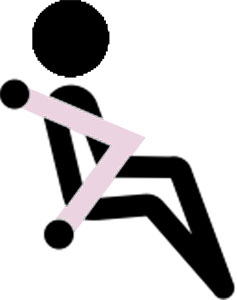In general, healthy pregnant women never have to stop driving. However, a pregnant woman should be aware of her slower reflexes and her tendency toward fatigue.

Driving when Pregnant
What you need to know about driving while pregnant?
It is perfectly fine that a pregnant woman doesn’t give up driving, but she should leave it to someone else when she is tired or not feeling well.
There are days when a pregnant woman may not be fit to sit behind the wheel, and she needs to be aware of this. She may be too tired to concentrate, nauseous, or she may find it very difficult to get behind the steering wheel physically.
Things that may affect driving during pregnancy
- lower concentration
- morning sickness
- fatigue & drowsiness
- towards the end of pregnancy, sudden contractions or water breaking while driving
If you are facing any of the listed problems, it is better to leave the driving to someone else.
Concentration:
A pregnant woman finds it harder to concentrate, therefore, she must focus solely on the driving and nothing else. Although it applies to everyone, it is particularly important that a pregnant woman doesn’t engage in telephony, food, drink, etc., but stays well-focused while driving.
The presence of other small children in the car is also an often cause of distraction. Kids are demanding, either they cry, they are hungry, if there are two, they may argue. Whatever the kid needs, it is usually not vital! A pregnant woman should first stop safely and only then takes care of it.
Morning sickness:
Morning sickness is a common problem in the first trimester. If a pregnant woman experiences severe nausea that strikes her suddenly, and if this happens often, she should not drive.
If she is sick only for a particular part of the day, for instance, in the morning or evening, she should avoid driving during this time.
Fatigue:
Women are more often tired during pregnancy or get tired faster than they would otherwise. If you are exhausted, your concentration is even worse, so do not drive!
Pregnant women are more likely to fall asleep faster. Driving when you are sleepy is never a good idea, especially during pregnancy!
Contractions or Water Brake while Driving
Do Not Panic!
Towards the end of the pregnancy, sudden contractions or sudden water brake may occur. Sure, it confuses a pregnant woman if it happens behind the wheel, but she should know that there’s nothing wrong with driving for a few more minutes until she can pull over safely.
There is no need to stop right away or even watch “between legs,” figuring out what’s going on down there while you are behind the wheel. A car accident puts a pregnant woman at greater risk than a sudden birth!
Though, it is recommended to leave the driving to someone else during the last days before birth.
Is it safe to drive while pregnant?
Yes, as mentioned above, it is generally safe to drive while pregnant! But a pregnant woman should be aware of her limitations and keeps them in mind while she is driving!
However, there are certain risks associated with driving that a pregnant woman should be aware of. The baby is generally well protected in the womb, but traveling by car can still be risky if you get into an accident.
If a pregnant woman is involved in an accident, even if it is seemingly harmless, she should always see a doctor!
Pregnancy and driving: Possible Risks
Are air bags safe for pregnant women?

According to experts, airbags are safe for pregnant women. They definitely protect more than they could hurt! However, an airbag is safe while using together with a seat belt, so don’t rely on just one or the other. The combination of both offers a pregnant woman the highest level of protection, as long as she is using them correctly.
Yes, airbags (front and side airbags) are considered safe for pregnant women. You shouldn’t turn them off, but you must sit as far back from the front airbag as possible, and use the seat belt correctly.
Does the steering wheel pose a danger to the pregnant woman?

The steering wheel poses a little higher risk for injuries in the case of an accident. To reduce the risk, you need to set it as ergonomically as possible.
Adjust the seat as far away from the steering wheel as possible. Your belly should not touch the steering wheel, but driving must still be comfortable for you. In the last trimester is keeping such distance between you and the steering wheel harder and harder, therefore, adjust the steering wheel so that it is tilted towards your chest, not towards your belly.
From this point of view, the back of the car stays the safest position for pregnant women.
Should a pregnant woman wear a seat belt?

A seat belt is mandatory in pregnancy! Wearing a seat belt is safer for the pregnant woman and the baby than if she wouldn’t use it.
The seat belt itself never causes damage to the fetus, so buckle up each and every time you get into a car!
How to use the seat belt properly during pregnancy?
- Pregnant women should use only a three-point seat belt, not a lap belt alone.
- The pregnant woman must always be properly belted!
- The lap strap must run above the pubic bone, below the belly, and fits snugly across the hips.
- The shoulder strap must run between the breasts, and over the shoulder, without lying against the neck.
How to Drive Safe While Pregnant
- Do not turn off airbags!
- Always use the seat belt! Use it correctly!
- Do not drive if you are tired or not feeling well!
- On long journeys, be a passenger rather than a driver.
- Make regular stops during long drives.
Why is taking regular stops while driving during pregnancy important?
Sitting for a long time is not only uncomfortable for a pregnant woman, but it can cause health issues as well. The risk of blood clots is higher in pregnancy (especially in the second half of pregnancy) and increases further during a long time sitting. However, this means sitting for several hours together, not one-hour rides.
Because of that, together with the reasons listed at the beginning (lower concentration, fatigue, etc.), it is not recommended that a pregnant woman drives for several hours together.
But if she has to, or if she is only a passenger on a long ride, she should stop at least every two hours. She should get out of the car, drink and eat something, and stretch her legs regularly. Even a few stretching exercises contribute to better blood circulation, less swelling, and the discomfort that driving may bring. Comfortable shoes and clothing may also help.
